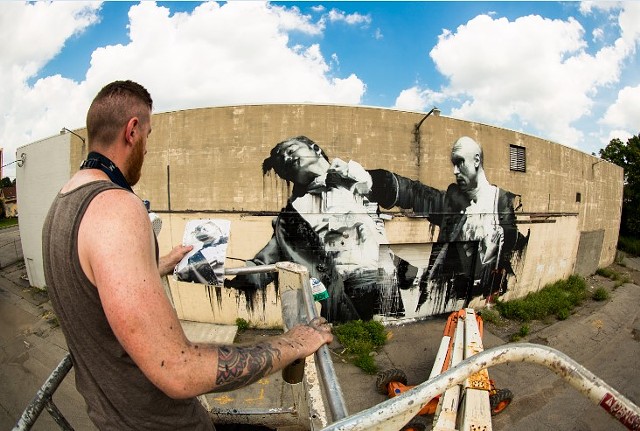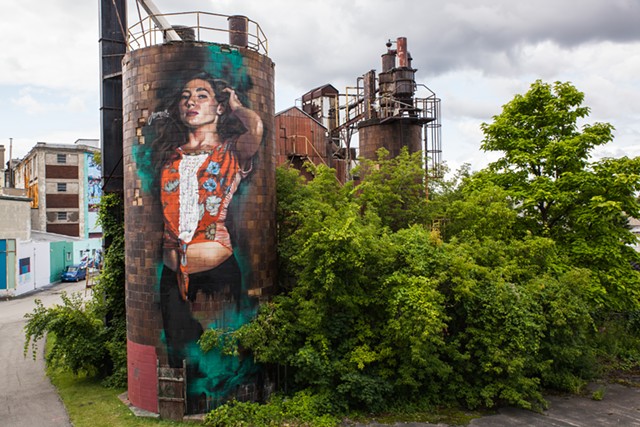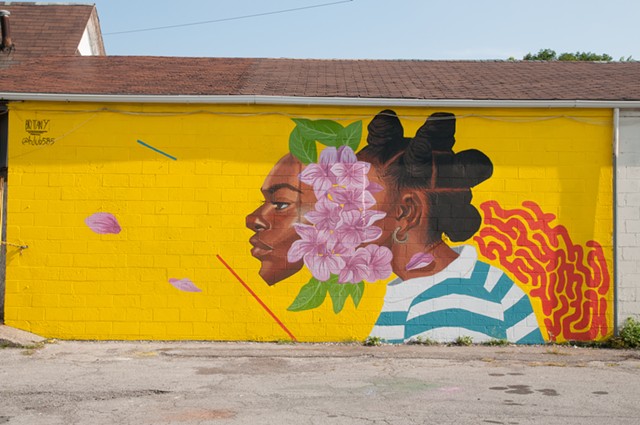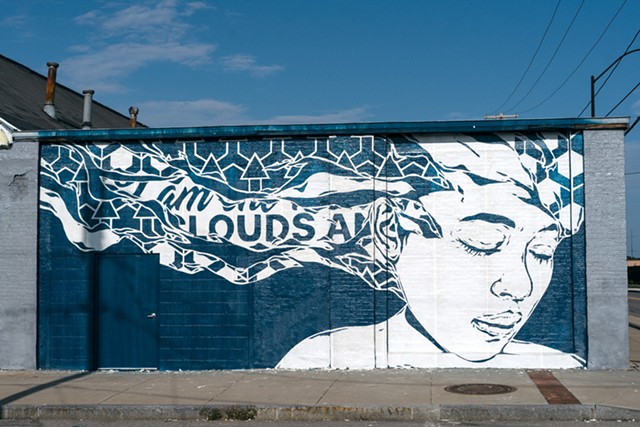
- PHOTO PROVIDED
- Irish artist Conor Harrington checks his sketch against his in-progress mural on the El Camino Trail in 2013. Harrington is among the Wall\Therapy alumni who will return to Rochester this month for Wall\Therapy's 10th anniversary festival.
While Wall\Therapy projects will extend beyond the summer — in that organizers will continue to facilitate the installation of murals and bring artists to Rochester — the week-long mural art festival is fading away like paint on weather-beaten brick.
“The challenges of maintaining it are numerous,” said Wall\Therapy founder Dr. Ian Wilson.
He and lead curator Erich Lehman said each festival requires fundraising, coordinating with traveling artists, booking flights and accommodations, wrangling volunteers, and planning related events.
Going forward, organizers said they’ll present project-based events that will welcome solo or small groups of artists to town throughout the year.
“This will allow us to be more nimble, and take more chances in who we're able to bring in or how we're able to work, things like that,” Lehman said.
This year’s artist roster includes six Wall\Therapy alumni: New Mexico-based Indigenous painter Nani Chacon (2018), London-based Irish artist Conor Harrington (2013), Canadian artist Jarus (2014), Native-Hawaiian artist Ian Kuali’i (2017), California-born artist Faring Purth (2013), and Rochester artist Brittany Williams (2015).

- PHOTO PROVIDED
- A mural by Canadian artist Jarus, titled "Avery," was installed at the Fedder Industrial Complex in 2014. Jarus will paint for Wall\Therapy again this year.
Rochester native Ephraim Gebre, known for his work on the John Lewis mural on State Street and the more recent painting of Minister Franklin Florence, Malcolm X, and Connie Mitchell on East High School, will create his first mural for Wall\Therapy with RIT professor and artist Luvon Sheppard. Also joining for the first time are Detroit-based artist Sydney G. James; Daniel Jesse Lewis of Berkeley, California; South African artist Elléna Lourens; and Keya Tama, who is the son of South African artist and Wall\Therapy alum Faith47.
Renowned street art photographer Martha Cooper will return to Rochester to photograph the festival once more, and the documentary about her life, titled “MARTHA,” is set for a July 26 screening in Cooper’s honor at The Little Theatre. The free screening will be followed by a Q&A with Cooper. Artist workshops and other events will be announced closer to the festival.

- PHOTO PROVIDED
- Rochester artist Brittany Williams painted for Wall\Therapy in 2015, and will reprise her involvement with Wall\Therapy for its 10th anniversary festival.
From there, the project erupted into an annual, highly-anticipated event that brought in artists from all over the world to paint walls throughout the city. In the process, it elevated the work of Rochester-based artists, and presented film screenings, dance parties, and conferences on public art.
It still comes as a surprise to some fans of the festival that everything Wall\Therapy accomplished was done without public funds.
Wilson and Lehman shouldered much of the annual expense, including artist compensation. Beginning in 2013, organizers also held an annual crowd-funding period ahead of each festival, with incentives of artwork and ephemera donated by artists and art lovers.

- PHOTO PROVIDED
- Native Hawaiian artist Ian Kuali'i installed this wheatpaste mural on the corner of Greenleaf Street and Atlantic Avenue in 2017. Kuali'i will paint in Rochester again this month.
Over the years, donations and other expressions of community support have outweighed detractors of the project who complained about murals they found offensive.
Mural designs weren’t approved by anyone. Property owners who agreed to allow their buildings to become a canvas did so with the understanding that the artist would have creative license.
“There was a certain audacity present since the beginning,” Lehman said, noting that a handful of naysayers had trouble wrapping their heads around the fact that a small group of art enthusiasts were putting up public art without public consent.
RELATED: Rochester's infamous 'Sleeping Bears' mural vandalized
Many of the murals are simply beautiful paintings — a captivating woman, children playing, or stylized depictions of animals. But others are more poignant reflections of artists who took a few days to soak up the city or the neighborhood they would be altering with their artwork.
At times, the artists responded to a current event and spoke with residents about its impact on them. In 2013, New Jersey-based artist LNY painted a mural on Joseph Avenue that incorporated images of Trayvon Martin, Frederick Douglass, and a little boy from the neighborhood.
“It's the conversations with the folks who live near the murals, who are going to live with those murals, and what it means to them,” Lehman said. “And more often than not, you have people who just appreciate the effort, and that someone has made something with their space in mind.”
This year, organizers gave participating artists the loose prompt to create work that tackles something they want to talk about regarding the state of the world.
Wall\Therapy’s message has remained fairly simple and down-to-earth: to use public art to inspire Rochesterians. That may have taken the form of a child moved to pick up a paintbrush, or a neighborhood resident finding a spring in their step, or an out-of-towner visiting the city to watch a mural go up.
“That act of coming together over art has the power to bridge gaps, to foster community and communication,” Lehman said.
Rebecca Rafferty is CITY's life editor. She can be reached at [email protected].
